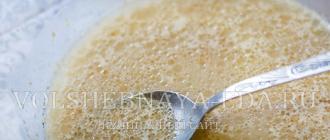Diversity today flooring is quite large, so more and more questions arise about what type of floor to choose. After all, the floor should be durable, practical, preferably natural, and, of course, beautiful to look at. Ideally, the flooring should be easy to install. In this article we will talk about marmoleum coating , which with its properties and features is attracting more and more attention.
So, what is this “marmoleum”? It is generally accepted that this modern material However, something similar to marmoleum was made back in the 17th century. By the way, not many could afford such luxury. But as we know, the new is the well-forgotten old. Floor marmoleum is absolutely natural material, in the production of which modern technologies are used.
What is marmoleum made from? How do they do it?
Marmoleum contains wood flour, crushed lime, pine resins and linseed oil. All “ingredients” are mixed in the required proportions until a homogeneous mass is obtained, after which this “dough” is sent to sealed bunkers and infused there for some time at a temperature of +30 0. At this stage, colored granules are added to the mixture so that the future natural marmoleum acquires the required color. Afterwards the mass is repeatedly sent under the press.
Next, the resulting material is laid on a jute or fabric base, shaped and sent to a drying chamber, where the temperature is maintained at 22-25 o C. Also here, a transparent protective material is applied to the material for easy care of the coating and its wear resistance.
Why is marmoleum so popular?
Well, you know what marmoleum is made of, now let’s look at its benefits. Due to the huge number of advantages, this flooring is used in both residential and public spaces, including those with high traffic. So, strengths Marmoleum flooring:
- As we have already found out, it is environmentally friendly, safe for health and hypoallergenic. In addition, it contains resins coniferous trees, which have a beneficial effect on the indoor microclimate. Therefore, the material is excellent for medical institutions and children's rooms.
- The relatively small thickness of marmoleum does not prevent it from being extremely wear-resistant. Material structure and protective coating make it very durable.
- The material is not subject to burning, smoldering or exposure chemicals. Therefore, it can be safely called safe. It is also moisture resistant, does not rot and is not afraid of insects.
- The material is easy to care for. Ordinary is enough for him wet cleaning without the use of special detergents.
- Impressive service life. If installation rules are followed and the coating is properly cared for, the material can last for decades. The most interesting thing is that over the years it becomes even stronger, again, due to its structure, because gradually it is compressed even more.
- Thanks to the wide variety of colors and shades, marmoleum in the interior is loved by many designers. In addition, over time the color does not fade under the influence of sunlight.
- You can lay a warm floor under marmoleum; under the influence of high temperatures it does not deform and does not lose its properties. Therefore, it is great for living rooms. Although the material itself has good thermal insulation properties and they rarely put a warm floor underneath it.
- The ease of installation allows you to perform the work without special preparation. You can easily cope with this task yourself. It can even be laid on old flooring.
In addition to a wide selection of colors, manufacturers offer this eco-coating with various textures. Marmoleum imitated with leather, stone, and wood is especially popular among buyers with refined tastes. 
Are there any disadvantages to marmoleum?
Eat. To be fair, it’s worth clarifying what you should pay attention to when choosing a floor covering, because the disadvantages of marmoleum can be off-putting:
- Price. Marmoleum costs a lot due to its naturalness, complexity and duration of production and special storage requirements. On average cost per square meter material starts at $25. In addition, for installation you will need a special glue designed for eco-linoleum.
- Fragility. The material requires careful transportation; you are unlikely to use damaged tiles. Therefore, when purchasing, carefully inspect the material to ensure there are no cracks. Marmoleum can be rolled into a roll only once, with the top layer facing out. This should also be remembered if you choose rolled marmoleum. But subject to simple rules storage and installation, this drawback will bypass you.
- Give him some time. One of the characteristics of marmoleum is its ability to “dissolve”. Therefore, before pressing it with the baseboard, let it rest and take shape. However, this property is suitable for the floor; there is no need to perfectly level the floor and seal the joints. A good brand of jack-moleum will “fall” into place over time.
- The structure of the material is rigid and not elastic. Therefore, it is not advisable to place heavy furniture on it; over time, holes may appear under it.
- The material does not cut well, it is almost impossible to achieve a perfectly even cut, so if the geometry of the room is incorrect, you will have to tinker.
We have figured out the pros and cons of marmoleum, now we will look at the varieties of this floor covering. 
Types of marmoleum and their areas of application
There are three classes of marmoleum, which determine its scope of application:
- 21-23. This is marmoleum, which is well suited for the interior of living rooms. The thinnest (has a decorative coating up to 2 mm). The cheapest of all classes.
- 31-33. Eco linoleum for use in industrial facilities. Resistant to prolonged static load, has a decorative layer thickness of up to 2.5 mm.
- 41-43. The thickest (up to 3 mm) marmoleum, which is ideal for public places with high traffic (train stations, airports, metro stations, hospitals, large stores).
If you want to lay marmoleum in a house or apartment, you should not think that the thicker it is, the better and longer it will last. The thinnest marmoleum will suit you, which will prevent it from “spreading” and forming pits under heavy furniture. 
Talking about types of marmoleum , it is worth mentioning various forms release of material:
- Tiled (supplied in tiles of sizes 30x30, 50x50). Installed with special glue.
- Panel, made in panels of 30x90 cm, laid in the same way as the tiled version.
- Rolled marmoleum. Such option will do for laying on large areas. It is a roll up to 2 m wide, which can be rolled out only once. If handled incorrectly, the material may become unusable and crack. This option is difficult to install and requires professionalism and experience. Therefore, if you want to lay marmoleum at home yourself, it is better to choose the two previous options.
When choosing marmoleum, considerable importance should be given to its design. Modern manufacturers offer a huge selection of marmoleum patterns, different textures, pigments. From individual tiles on the floor you can assemble a full-fledged pattern, so this material provides good opportunities for interior designers.
Marmoleum is an environmentally friendly material for finishing floor. The flooring has a natural composition, made from cork, jute, resin, vegetable oils. Reviews about marmoleum in the apartment are mostly positive. Consumers note the good performance characteristics of the flooring.
Natural material managed to occupy a niche in the market thanks to:
- resistance to contact with chemicals;
- strength in relation to physical impact;
- moisture resistance, inability to deform under the influence of water;
- natural composition that does not cause an allergic reaction;
- simple installation that does not require special skills;
- ability to withstand high temperature, which allows you to install a floor heating system;
- the bactericidal properties of marmoleum, making the material suitable for use in children's and medical institutions;
- Possibility of reuse provided that the surface is thoroughly cleaned of glue;
- resistance to sunlight;
- no need for careful sealing of seams, careful leveling of the base due to the property of the material to spread and harden over time;
- interesting external design (for example, marmoleum imitating wood, stone, etc.), an effective combination of shades, which creates a unique pattern.
Important Disadvantages
Flooring, in turn, has certain disadvantages. Reviews indicate the following disadvantages:
- Fragile, high risk of edge damage. When moving, care is required during the transportation process;
- Rigidity, lack of flexibility. This creates certain difficulties during storage and transportation;
- The property of spreading and hardening. When purchasing marmoleum, you need to pay attention to the production date and shelf life;
- Cannot be used for finishing walls or ceilings. The coating retains residual plasticity and is able to “float” under its own weight;
- Difficulties when cutting, problems with creating a straight edge. The material is cut only along the walls, where the edge of the flooring will be covered with a plinth;
- High cost due to the use of high-quality natural raw materials.
Specifications
Natural flooring confidently occupies its own niche in the flooring market. The material must be excellent technical characteristics to its composition. What is marmoleum made of? The coating is made from:
- ground bark balsa wood;
- jute stems;
- vegetable resin;
- crushed chalk (calcium carbonate);
- flax seed oils.
 Compound
Compound During the manufacturing process, all components are combined in a certain proportion and mixed. The resulting mass settles for a week. Next, a natural color pigment is added, thanks to which the flooring acquires a certain color. This is followed by pressing and cutting to a given size, which can result in rolled material, square slabs or long strips. The final stage of flooring production is drying the products.
Release form
forbo marmoleum is produced in the following types:
- Touch is a material with a textured surface and anti-slip properties. Modern coating is intended for fitness centers and gyms;
- Walton is a discreet, monochromatic flooring. The material has an interesting texture, allowing you to implement stylish design solutions;
- Artoleum - a coating with a bright pattern based on the works of famous artists;
- Marmoleum is a durable flooring with a striking pattern reminiscent of natural stone.
Classes
The produced flooring has varying degrees wear resistance, designed for a certain load. Marmoleum is presented in the following classes:
 When choosing, consider class affiliation
When choosing, consider class affiliation - 21-23 - the thinnest coating with the most affordable price. The material is intended for an apartment, a private house, a small office with little traffic. Warranty period operation life of marmoleum of this class is 20 years;
- 31-33 - industrial flooring with a decorative layer thickness of 2.5 mm. The coating can withstand medium loads and is suitable for installation in an enterprise, production workshop, or large office;
- 41-43 - the most durable, reliable flooring with a top layer thickness of 3 mm. The coating is intended for places with high traffic - shopping centers, airports, train stations. The flooring can withstand up to 100 thousand attacks daily for 5 years.
Read detailed instructions depending on the room.
Characteristics and sizes
Marmoluem Forbo is available in the following form:
- Roll covering with standard width 2 m. The thickness of the flooring varies between 2 and 4 mm, depending on the class of the flooring. This is the most early form release of material. Rolled marmoleum is used in spacious rooms and requires professional installation skills;
- Square slabs measuring 50 by 50 cm or 30 by 30 cm. This marmoleum is relatively easy to work with and allows you to create beautiful patterns and compositions on the floor;
- Panels 90 by 30 cm, equipped with a locking system. Laying the material is simple, reminiscent of installing laminate flooring.
How does installation work?
Often, the installation of marmoleum does not require careful preparation of the base. Natural flooring can be laid over old flooring using mounting adhesive. If the previous material is very worn out, it is better to dismantle it. In this case, the coating is laid on concrete base without additional thermal insulation, as required by linoleum. Marmoleum retains heat excellently.
 Installation of square slabs with glue
Installation of square slabs with glue If differences in the height of the base do not exceed 2 mm, no additional leveling is required. Otherwise, you need to remove sharp protrusions with a drill or grinder. After treatment, the dust is swept off the floor, the remainder is collected with a vacuum cleaner, and the base is sprayed with water. To install natural linoleum on an old coating, square slabs fixed with glue are suitable. Due to their fragility, oblong panels are recommended to be laid on a concrete base.
When starting work, you need to determine the number of solid elements and determine the need for cutting. Then the rows that will be located along the length of the room are counted. When measuring, take into account a gap of 1.5-3 cm around the perimeter. The coating tends to deform and rise over time. The resulting joint is covered with skirting boards.
Installation of natural flooring can be done using the same tools used when laying laminate flooring. Marmoleum requires great care. The edge of the coating is fragile and can easily deform. A rubber or wooden hammer or a hook clamp with a hook of at least 15 cm are ideal for the job.
Rolled marmoleum flooring
Rolled material is installed mainly in spacious commercial premises. Installation process decorative covering similar in general to flooring of commercial, semi-commercial types of linoleum. At the same time, working with marmoleum is more complex and requires special knowledge and skills, taking into account the characteristics of the material.
 Installation with glue
Installation with glue There are basic nuances that you need to pay attention to. Installation of the flooring requires absolute cleanliness and strength of the base. Before laying the material, remove traces of paint and any oily substances. The roll covering is secured with special glue. Seams are welded using a special cord made of low-melting polymer.
Click tile
Square tiles equipped with a locking system are laid on plastic material. The film, laid overlapping, prevents the formation of condensation under the marmoleum. Click tiles do not require the use of a binder; installation is carried out using the “floating” method. The flooring is mounted and fixed with a tongue-and-groove system. The first slab is laid 1 cm from the wall with the ridge to the wall and the groove in the opposite direction. Subsequent elements are inserted at a slight angle into the groove of the previous plate.
The second row is laid in the same way at an angle, taking into account the compensation gap. The required seam is formed using a block placed under the tile. After installation is completed, the block is removed and the locks are latched. WITH last element part of the groove is removed, then a little glue is applied to the coating. The tile is lined with a block. Upon completion of installation, you should check the evenness of the rows and the presence of compensation gaps at the walls. Next comes the installation of the baseboard.
Laying panels
Marmoleum flooring, produced in the form of panels, is easy to install. In terms of speed of work, the installation of panels is ahead of the installation of traditional tile material. When finishing the floor, you must follow safety rules and handle the coating carefully. The material is fragile, cracks and deformations easily form on it. The spikes on the sides of the element may be damaged.
Care
In residential areas with minimal traffic, daily dry vacuuming is recommended. How to wash marmoleum? Once a week, wipe the floor with a well-wrung cloth and a mild detergent. It is not advisable to wash marmoleum with abrasive sponges, which can damage top layer. The presentable appearance of the floor can be maintained by using special cleaning products.
Modern consumers place quite high demands on floor coverings. And, although the choice of materials in stores is impressively large, it can be difficult to find a coating that is ideal in all respects.
The floor should not only be aesthetically pleasing, but also strong and durable. It should not be afraid of moisture and exposure to detergents; it should be as natural and environmentally friendly as possible. At the same time, few people will be able to pay a lot of money for a really high-quality floor covering, such as, for example, for a cork floor.
Most of those for whom the choice of flooring is relevant will want to take a closer look at marmoleum. It is this material that is confidently winning more and more new fans.
What is marmoleum?
The words “marmoleum” and “linoleum” are consonant and have a similar nature. The difference is that linoleum is a synthetic material, and marmoleum is natural. It is made from a mixture of different natural ingredients: cork, wood flour, chalk, jute. It's all soaked in natural oils and dyes, pressed, cut. The manufacturing technology of marmoleum is constantly being improved, which ultimately gives the consumer a greater choice of colors, textures and greater wear resistance of the fabric.

Marmoleum coating composition
Marmoleum is chosen for flooring in residential areas, but it is so reliable that it can also be successfully used in public places. So, manufacturers offer 3 classes of this material.
- 41-43 – the most stable and reliable, can be used in areas with constant high traffic, such as train stations and airports. The thickness of its decorative layer is more than 3 mm, which makes it unsurpassed in wear resistance.
- 31-33 – considered industrial marmoleum. Can be installed on the floor of large offices and enterprises. The thickness of the decorative layer is already less than 2.5 mm, but this still allows us to talk about many years of service for such a coating.
- 21-23 is the thinnest and cheapest, but that doesn’t mean it’s bad. It is used for apartments, private houses and small offices. The guaranteed service life of such marmoleum is at least 20 years!
Advantages of linoleum marmoleum
Marmoleum is perhaps the only floor covering that has such an impressive list of advantages over its competitors. Let's label them all:


Marmoleum is moisture resistant, ideal for country houses
The advantages of marmoleum are quite enough to make it popular among buyers. However, in fairness, it is necessary to point out the shortcomings, although they are not so significant.
Marmoleum is a material that will be equally appropriate in the kitchen, in the nursery, and in the living room. In pursuit of durability, experts do not recommend using coatings of the highest wear resistance class. Such marmoleum weighs heavier and costs more, but does not justify its price.

Photo: marmoleum linoleum is good in the kitchen
The coating is sold in tiles, panels or small rolls with a width of 2 meters. Since this product is one-piece, you can combine pieces of different shades (fortunately there are several hundred of them), creating a unique floor covering.
Manufacturers of natural linoleum constantly offer consumers some innovations. One of the latter is marmoleum with a laminate-type locking mechanism. This material will create a perfectly flat surface without noticeable joints.
No matter how much you would like to see marmoleum in the interior as soon as possible, you should not install it right away. The material should be allowed to “sit” in the room and acclimatize. This is especially true in the cold season.
Marmoleum does not require a substrate or additional floor treatment. The main condition is a surface with unevenness of no more than 2 mm. When installed correctly, this flooring will last for many years. The only negative is that it will get pretty boring during its impeccable service!
What is marmoleum? This is a new material for flooring, the production of which is rapidly developing. In the future, marmoleum will most likely replace all types of floor coverings, except wooden parquet from valuable species wood that will remain as a luxury item.
This explosive spread of marmoleum is due to its truly outstanding advantages:
- Marmoleum is absolutely environmentally friendly, it is made only from natural ingredients, and they are so cheap that counterfeiting is not economically justified.
- Marmoleum is non-toxic, does not cause allergies, and in addition also has bactericidal properties.
- Marmoleum is cheap: a marmoleum floor is 15-30% cheaper than the cheapest current material - laminate.
- A marmoleum floor does not require additional insulation or thermal insulation: the material itself has insulating properties.
- Marmoleum is durable and hygienic: it does not fade, does not swell when wet and does not warp, withstands enormous local loads, and even spilled paint does not stick to it. The guaranteed service life of marmoleum is 20 years, but judging by the structure and manufacturing technology, in the future it will be increased to 100 years.
- Marmoleum does not accumulate static electricity and is not flammable: a cigarette butt thrown on it will smolder without leaving a trace, and it is only possible to burn through marmoleum with an autogenous gun.
- Marmoleum is decorative: it can be painted in the most different colors, texture like wood, stone, etc. Currently, marmoleum is produced in 100 primary colors and more than 2000 shades.
- And finally, marmoleum is extremely easy to work with: literally a preschooler can do the laying of marmoleum with his own hands.
Video: marmoleum, its safety and basic installation points
A little history
How did such a wonderful material come into being? This took several centuries.
Even in ancient times, fabrics were impregnated with oil to increase their durability. By the 17th century In Europe, jute came into use - a very coarse and durable burlap made from fibers of plants of the genus Corchorus linden family: Indian flax, Calcutta hemp, Tossa jute. At the same time, oiled jute fabric, coated with various hardening compounds, began to be used for flooring. The prehistory of marmoleum ended in 1863 with British Patent No. 209/1860 for linoleum, issued to Frederick Walton. In 1864, mass production of linoleum began.
Walton managed to develop a very cheap and fairly durable top coat based on linseed oil, pine resin (resin), wood flour, natural dyes and chalk. After World War II, natural linoleum replaced PVC-based linoleum, but the global oil crisis and increased environmental awareness revived the demand for natural linoleum, which contributed to the improvement of its manufacturing technology.
By the beginning of the 90s, even cheaper and higher-quality substitutes for linseed oil and resin, obtained from highly productive tropical crops, were found. At the same time, a third, intermediate layer of pressed cork chips was introduced into the linoleum structure. The finishing touch was the use of hot dry pressing technology, developed for the production of MDF, in the production of linoleum.
The coatings obtained in this way went on sale under common name marmoleum. In fact, marmoleum is natural linoleum taken to the limit of its perfection.

Marmoleum is especially good for children's rooms.
Disadvantages of Marmoleum
There is no such thing as complete perfection, so marmoleum also has its drawbacks.
- Firstly, marmoleum is fragile, especially around the edges, and when working with it you need to be careful certain rules; see below. You can roll marmoleum into a roll once with the base facing out.
- Secondly, marmoleum spreads a little over time and hardens. This is good for the floor: you don’t need to carefully seal the seams, they will come together on their own. But when buying marmoleum, you need to carefully study the manufacturer’s instructions for that particular brand and check the shelf life. If boxes with tiles or rolls were subjected to careless handling during transportation, some of the material may end up with cracks, so you need to look for a seller with a guarantee.
- Thirdly, marmoleum is heavy and at the same time retains residual plasticity along the layers for a long time. Again, this is good for the floor: there is no need for careful leveling of the base; Marmoleum will cover irregularities of a quarter or even a third of its thickness, and its surface will remain smooth. But you can’t use marmoleum to decorate walls and especially ceilings: the coating will “float” under its own weight. Marmoleum is exclusively a floor covering.
- Fourthly, marmoleum does not cut well and it is impossible to achieve a smooth, even cut, like on laminate or MDF. Therefore, marmoleum is cut only along the walls to size, where the cut is covered by the baseboard. That is, decorative possibilities When installing marmoleum yourself, you are limited to laying out a pattern of standard tiles.
Characteristics, classification, standard sizes
The technical characteristics of marmoleum have actually already been described. It remains to add that it can withstand a load of 160 kg/sq.m. without permanent deformation. see (!), it specific gravity is 2.6 – 3.4 kg/sq. m, and the total thickness is 2-4 mm depending on the class.
Marmoleum is available in the following classes:
- 41-43 – top decorative layer more than 3 mm thick. Withstands up to 100 thousand attacks per day for 5 years. Designed for public premises with a large flow of visitors; for example, large international airports.
- 31-33 – industrial. The thickness of the decorative layer is up to 2.5 mm. It holds alternating loads worse than 41-43, but is more resistant to static loads.
- 21-23 – general purpose. It differs from industrial only in its thinner coating (up to 2 mm) and in price - it is cheaper.
Conclusion: do not buy the thickest and most expensive marmoleum for your home. From the legs of concentrated loads: cabinets, aquarium stands, holes can form in it over time. For yourself, buy the cheapest one.
The standard sizes of marmoleum are as follows:
- Rolls 2 m wide. Rolled marmoleum for self-installation not suitable - to handle it you need a forklift, a crane and a team of experienced riggers. Once you have rolled out the roll, you cannot roll it back. Due to the heaviness and fragility of the material, working with long strips in an apartment is extremely inconvenient.
- Tiles 50x50 cm and 30x30 cm. They are laid with glue, like PVC or ceramic tiles.
- Panels 90x30 cm. Lay like tiles.

Laying marmoleum
Tool
When laying marmolium, laminate tools must be used carefully: the edges of the tiles or panels are fragile. It is better to stock up on a wooden or rubber hammer (mallet) and a rule (clamp-hook) with a wide hook, at least 150 mm. The rest of the instruments are ordinary.
To the previous coating
Marmoleum can be laid directly on the existing floor covering using any installation adhesive. But, if the old floor is playing or it has been trampled to the point of depressions, then the previous covering must be removed and the marmoleum should be laid on bare concrete. There is no need to worry about heat/sound insulation - marmoleum itself is an excellent insulator.
Marmoleum tiles are laid end-to-end on the previous coating using glue. It is not advisable to use panels - on an old rough floor they can get stuck during adjustment.
Preparing the base
The concrete base or cement-sand screed for marmolium, if there are noticeable protrusions on it, needs to be leveled. It is imperative to remove sharp protrusions more than 1.5-2 mm high. This can be done with a drill or grinder using a bowl-shaped circle on the stone. If the cup accidentally crashes into concrete, it’s okay; the depression can be sealed with cement mortar or starting putty. After leveling, the dust needs to be swept away, the remains collected with a vacuum cleaner, then sprinkled with water and swept again.
An option “for the lazy”, but more expensive: cover the base with a plastic pillow under the laminate. In any case, no pre-treatment of the base with bitumen primer, etc. not required.

Marmoleum for offices, on which company symbols are applied, is gaining particular popularity.
Cutting material
- We measure how many solid tiles or panels will fit across the width of the room; then - how long the rows will be. We take into account a gap of 15-30 mm around the perimeter; it will be covered with a plinth. The gap is needed so that due to temperature and plastic deformations of the coating it does not swell over time.
- We cut the remainder of the whole to length using a jigsaw or hand circular saw the number of tiles/panels equal to the number of transverse rows.
Example: room in plan 4x6 m; cover with panels. The remainder of the whole is 400 - (90x4 = 360) = 40 cm. The length is 600/30 = 20 rows. Cut 20 pieces 36 cm long (36x30 cm).
When laying with a comb, with offset transverse seams, the cutting ends there. If you want to lay out the rest of the whole evenly around the perimeter, each piece needs to be cut in half lengthwise. In the example, you will get 40 pieces of 18x30 cm.
Laying process
How to lay marmoleum on concrete? Very simple:
- Close to the far short wall we lay a 15-30 mm lath, wrapped in thin plastic film. The film will not allow the rail to stick from accidental glue drips. We lay the same strip along the long left wall; if you are left-handed, then along the right.
- We start laying from the far left corner (from the right - for left-handers). In place of the future tile, apply assembly adhesive, construction silicone or linoleum mastic using a snake. We lay the tiles and push them tightly into the corner. If necessary, we use a rule and a mallet.
- We lay out transverse rows, row by row, until the entire area is filled. We wait for the glue to set as indicated in the instructions for it. That's it.
Explanation: if you are laying with a comb, then start the rows alternately with a solid panel, then with a cut one. When laying out the remainder of the whole along the perimeter, each row begins and ends with a trim.
Today, the trend of using materials made from natural ingredients during home decoration and construction is becoming increasingly popular. Marmoleum is exactly such a material, and what is marmoleum let's figure it out. Marmoleum is a natural linoleum, which is the heir to “oiled canvas”, the very first environmentally friendly coating. Let us remember that for its manufacture they used fabric on which linseed oil, beeswax, resin and dyes were applied. Process The production of marmoleum is somewhat different, however, the tradition of using natural ingredients has remained unchanged: resin, jute, cork bark and linseed oil.
 Thanks to environmental safety marmoleum used in a wide variety of fields. These are office premises, apartments and private houses, restaurants and shops. But marmoleum is especially often used for flooring in children's, educational and medical institutions. It has been scientifically proven that those in linseed oil Unsaturated fatty acids prevent the proliferation of harmful bacteria and help reduce allergic and inflammatory reactions.
Thanks to environmental safety marmoleum used in a wide variety of fields. These are office premises, apartments and private houses, restaurants and shops. But marmoleum is especially often used for flooring in children's, educational and medical institutions. It has been scientifically proven that those in linseed oil Unsaturated fatty acids prevent the proliferation of harmful bacteria and help reduce allergic and inflammatory reactions.
 Let's talk about the advantages of marmoleum. In addition to environmental friendliness, which is undoubted advantage This flooring has many more useful qualities. Resistant to chemicals (solvent, acid). Extraordinarily high strength. The material is capable of withstanding a load of 160 kg per square centimeter without traces of deformation. Marmoleum easy to care for, does not attract dust and is very easy to clean. You can easily remove any stains from the coating, even paint. A wide range of colors (up to 2000 shades and colors) allows you to choose the desired shade for absolutely any interior.
Let's talk about the advantages of marmoleum. In addition to environmental friendliness, which is undoubted advantage This flooring has many more useful qualities. Resistant to chemicals (solvent, acid). Extraordinarily high strength. The material is capable of withstanding a load of 160 kg per square centimeter without traces of deformation. Marmoleum easy to care for, does not attract dust and is very easy to clean. You can easily remove any stains from the coating, even paint. A wide range of colors (up to 2000 shades and colors) allows you to choose the desired shade for absolutely any interior.
The decorative effect of marmoleum is explained by the fact that the pattern is applied over the entire thickness, and this ensures wear resistance and resistance to fading during operation. Marmoleum is completely fireproof and can be safely used in the kitchen. In addition, marmoleum is a pretty good sound insulator. The durability of the material reaches 35 years, of course, subject to careful use and correct installation. It is impossible not to mention moisture resistance, which is guaranteed special coating, characterized by water-repellent properties.
 Marmoleum is made in the form of tiles and roll material, which makes it possible to use a certain type based on needs. Installation allows you to lay the coating efficiently and quickly in the shortest possible time. It is very important to strictly adhere to the installation instructions; it is better to calculate the required number of rolls or tiles in advance, which will greatly facilitate the work. The only drawbacks marmoleum coating hardness and fragility are considered. Because of this, special care is required when handling the tiles during transportation. If we talk about the price, which is higher than the cost of standard artificial linoleum, then it, of course, is fully justified, taking into account the durability and advantages of the coating.
Marmoleum is made in the form of tiles and roll material, which makes it possible to use a certain type based on needs. Installation allows you to lay the coating efficiently and quickly in the shortest possible time. It is very important to strictly adhere to the installation instructions; it is better to calculate the required number of rolls or tiles in advance, which will greatly facilitate the work. The only drawbacks marmoleum coating hardness and fragility are considered. Because of this, special care is required when handling the tiles during transportation. If we talk about the price, which is higher than the cost of standard artificial linoleum, then it, of course, is fully justified, taking into account the durability and advantages of the coating.
Now you know, you can safely go to the building materials store and find out about its availability for sale.
Sincerely,
P.S. Did you like the article? I recommend ->>subscribe to receive the latest articles by e-mail<<- , чтобы не пропустить самые свежие вкусняшки!






